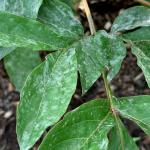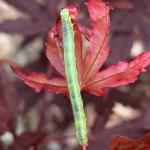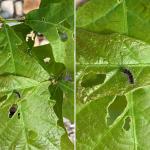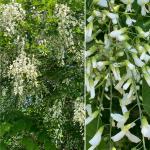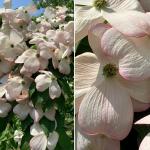UMass Extension's Landscape Message is an educational newsletter intended to inform and guide Massachusetts Green Industry professionals in the management of our collective landscape. Detailed reports from scouts and Extension specialists on growing conditions, pest activity, and cultural practices for the management of woody ornamentals, trees, and turf are regular features. The following issue has been updated to provide timely management information and the latest regional news and environmental data.
The Landscape Message will be updated weekly in June. The next message will be posted on June 4. To receive immediate notification when the next Landscape Message update is posted, be sure to join our e-mail list
To read individual sections of the message, click on the section headings below to expand the content:
Scouting Information by Region
Environmental Data
The following data was collected on or about May 26, 2021. Total accumulated growing degree days (GDD) represent the heating units above a 50° F baseline temperature collected via regional NEWA stations for the 2021 calendar year. This information is intended for use as a guide for monitoring the developmental stages of pests in your location and planning management strategies accordingly.
|
MA Region/Location |
GDD |
Soil Temp |
Precipitation |
Time/Date of Readings |
||
|
1-Week Gain |
2021 Total |
Sun |
Shade |
|||
|
CAPE |
74.5 |
238 |
63 |
58 |
0.06 |
12:00 PM 5/26 |
|
SOUTHEAST |
92 |
280 |
82 |
65 |
0.15 |
3:30 PM 5/26 |
|
NORTH SHORE |
126.5 |
334 |
62 |
56 |
0.05 |
10:00 AM 5/26 |
|
EAST |
122.5 |
351.5 |
69 |
62 |
0 |
4:00 PM 5/26 |
|
METRO |
121.5 |
326.5 |
64 |
57 |
0 |
5:45 AM 5/26 |
|
CENTRAL |
123.5 |
342.5 |
70 |
68 |
0.23 |
3:00 PM 5/26 |
|
PIONEER VALLEY |
124 |
342 |
66 |
58 |
0 |
11:00 AM 5/26 |
|
BERKSHIRES |
113.5 |
247 |
63 |
60 |
0.02 |
8:00 AM 5/26 |
|
AVERAGE |
112 |
308 |
67 |
60 |
0.06 |
_ |
|
n/a = information not available |
||||||
Check the drought status as of 5/25 here: https://droughtmonitor.unl.edu/CurrentMap/StateDroughtMonitor.aspx?MA
Current municipal water restrictions are shown on this map: https://www.mass.gov/doc/water-use-restrictions-map/download
Phenology
| Indicator Plants - Stages of Flowering (BEGIN, BEGIN/FULL, FULL, FULL/END, END) | ||||||||
|---|---|---|---|---|---|---|---|---|
|
Enkianthus campanulatus (redvein enkianthus) |
* |
* |
Full |
Begin |
* |
Full |
Full |
Begin |
|
Rhododendron catawbiense (Catawba rhododendron) |
Begin/Full |
Full/End |
Full/End |
Full |
Full |
Begin/Full |
Full |
* |
|
Deutzia spp. (deutzia species) |
Begin/Full |
End |
Full |
Full |
Full |
Full |
Full |
Begin/Full |
|
Aesculus hippocastanum (common horsechestnut) |
Full |
Full |
Full |
Full |
Full |
Begin/Full |
Full |
Full |
|
Rhododendron carolinianum (Carolina rhododendron) |
Full/End |
* |
Full/End |
Full/End |
Full |
Full |
Full |
Full |
|
Elaeagnus umbellata (autumn-olive) |
End |
End |
* |
End |
Full/End |
Full/End |
Full/End |
Full |
|
Spiraea x vanhouttei (Vanhoutte spirea) |
Full/End |
Full/End |
Full/End |
Full/End |
Full/End |
Full/End |
Full/End |
Full |
|
Syringa vulgaris (common lilac) |
End |
Full/End |
End |
End |
End |
End |
End |
Full |
|
Cornus florida (flowering dogwood) |
Full/End |
End |
Full/End |
Full/End |
Full/End |
Full/End |
Full/End |
Full/End |
|
Rhododendron spp. (early azaleas) |
End |
End |
Full/End |
Full |
Full/End |
Full/End |
End |
Full/End |
| * = no activity to report/information not available | ||||||||
Regional Notes
Cape Cod Region (Barnstable)
General Conditions: The average temperature for the period from May 19 – May 26 was 60˚F with a low of 44˚F on May 21 and a high of 86˚F on May 23. The period was mostly sunny and there was no significant precipitation. Weather conditions have been favorable, with late spring and some summer like conditions. The lack of precipitation is a concern; the last significant rainfall was on May 10. The lack of soil moisture is troubling, especially for tilled, disturbed or sandy soils. Make sure new plantings are being watered properly. Herbaceous plants seen in bloom the past week include columbine, bearded iris, lupine, bloodred geranium, lily of the valley, Solomon’s seal, vinca vine, fringed bleeding heart, sweet woodruff, painted daisies, and allium. Woody plants in bloom include wisteria, beach plum, flame azalea, doublefile viburnum, Korean spice viburnum, dwarf fothergilla, weigelia, and golden chain tree. Oak pollen is abundant. Now is the time to pinch herbaceous plants like chrysanthemum, aster, and goldenrod.
Pests/Problems: Insect pests or damage seen over the period include winter moth damage to maples (holes in leaves), rose (holes in leaves), blueberry (flower damage and holes in leaves), and apple (flower damage and holes in leaves); viburnum leaf beetle larvae on viburnum, hydrangea leaftier on smooth leaf hydrangea, columbine leaf miner on columbine, rose slug sawfly larvae on rose, Japanese maple scale on privet, lilac borer damage on privet, white prunicola scale on lilac, lecanium scale on white oak, boxwood leafminer adults emerging on boxwood, iris borer on bearded iris and aphids on numerous woody and herbaceous species. Disease symptoms or signs observed during the period have been limited; armillaria on privet and sycamore anthracnose on sycamore. Invasive plants in bloom include burning bush, autumn olive, bush honeysuckles, garlic mustard, and cypress spurge. Weeds in bloom include buttercup, narrowleaf plantain, red sorrel, black medic and white clover. Rabbits and deer ticks are abundant.
Southeast Region (Dighton)
General Conditions: We've had some very pleasant cool crisp weather interspersed with a couple of days in the 80's. Passing showers and threatened thunderstorms have produced very little in the way of addressing the lack of soil moisture. It's been fairly breezy as well. All in all, these have been comfortable conditions for humans to be outdoors but we are already in desperate need of rain for most of the other life forms. On a positive note, I'm not seeing any powdery mildew or other fungus problems that appear when there is free water on leaves. Even here on the water, there hasn't been morning dew in several weeks. It's dry enough that anthracnose infected sycamore trees are beginning to have a bit more than just a terminal leaf, something that doesn't usually occur until summer. Among the many plants I've noticed in flower are the following: Achillea millefolium (common yarrow), A. x 'Moonshine', Allium spp.(flowering onion), Aquilegia (columbine), Aesculus hippocastanum (horse chestnut), Baptisia australis (blue indigo), Coreopsis spp. (tickseed), Chionanthus virginicus (white fringetree), Chelidonium majus (greater celandine), Conium maculatum (poison hemlock), Convallaria majalis (lily of the valley), Cotinus coggygria (smoke bush), Cornus kousa (Chinese dogwood), C. sericea (redtwig dogwood), Cytisus scoparius (Scotch broom), Dianthus spp. (pinks), Deutzia, Euonymus alatus (winged euonymus, burning bush), Euphorbia epithymoides (yellow spurge), Geranium maculatum (wild geranium), G. sanguineum (cranesbill geranium), Hesperis matronalis (dame's rocket), Heuchera (coral bells), Hyacinthoides hispanica (wood hyacinth), Iris germanica (German iris), I. pseudacorus (yellow flag iris), I. sibirica (Siberian iris), Kalmia latifolia (mountain laurel), Kerria japonica 'pleniflora', Laburnum anagyroides (golden rain tree), Lamprocapnos spectabilis (bleeding heart), Leucanthemum vulgare (oxeye daisy), L. x superbum (shasta daisy), Lonicera morrowii (Morrow's honeysuckle), L. sempervirens (Japanese honeysuckle), L. tatarica (Tatarian honeysuckle), Lupinus (lupine), Myosotis (forget-me-not), Nepeta spp. (catmint), Osmunda claytoniana (interrupted fern), Ornithogalum (star of Bethlehem), Paeonia (peony) Papaver orientale (oriental poppy), Paulownia elongata (empress tree), Phlox subulata (creeping phlox), Pilosella (hawkweed), Polygonatum biflorum (Solomon's seal), Prunus serotina (black cherry), Vaccinium corymbosum (highbush blueberry), Viburnum x burkwoodii (Burkwood viburnum), V. plicatum, (double-file viburnum), Viola papilionacea (common violet), V. tricolor (Johnny-jump-up), Vinca minor (periwinkle), Ranunculus repens (creeping buttercup), Rheum rhabarbarum (rhubarb), Robinia pseudoacacia (black locust), Rosa rugosa (beach rose), R. 'Knockout Rose', Rhododendron catawbiens (evergreen and semi-evergreen azaleas), Salvia nemorosa (perennial sage), Silene latifolia (white campion), Spiraea prunifolia (bridal wreath spirea), Syringa vulgaris (common lilac), S. x persica (Persian lilac), Trifolium repens (white clover), Weigela, and Wisteria sinensis.
Pests/Problems: I fear the beginnings of a drought so deep even your dreams will be wilted. Unless we get some significant precipitation, the first heat wave will be devastating.
North Shore (Beverly)
General Conditions: Dry conditions persisted during this period. The weather was sunny, dry and warm with little cloud cover. The average daily temperature for this period was 67˚F. The highest temperature during this reporting period was 87˚F, recorded on May 26, and the lowest temperature was 49˚F recorded on May 20. A quick, light shower passed through on May 24 and dropped just 0.05 inches of precipitation at Long Hill. The top soil is dry but the subsoil is still a bit moist. Some plants in sunny dry areas are showing signs of water stress. Water those plants if possible. Recently planted trees, shrubs and perennials should also be watered. Woody plants seen in bloom include: many azaleas and rhododendrons, common horse chestnut (Aesculus hippocastanum), constellation Rutgers flowering dogwood (Cornus rutgersensis), handkerchief tree (Davidia involucrata var. vilmoriniana), common lilac (Syringa vulgaris), doublefile viburnum (Viburnum plicatum var. tomentosum), slender deutzia (Deutzia gracilis), wisteria (Wisteria floribunda), little leaf lilac (Syringa microphylla), sapphireberry (Symplocos paniculata), American cranberrybush viburnum (Viburnum trilobum), white tree wisteria (Wisteria floribunda ‘Alba’), umbrella tree (Magnolia tripetala), redvein enkianthus (Enkianthus campanulatus), pagoda dogwood (Cornus alternifolia), golden chain tree (Laburnum anagyroides), Scotch laburnum (Laburnum alpinum) and tree peony (Paeonia suffruticosa) . Herbaceous plants in bloom include: Scotch rose (Rosa spinosissima), Father Hugo rose (Rosa hugonis), columbine (Aquilegia canadensis), Japanese primrose (Primula japonica), doll’s eyes/white baneberry (Actaea pachypoda), Allium (Allium spp.) honesty plant (Lunaria annua), trillium (Trillium spp.) and fetterbush (Leucothoe fontanesiana).
Pests/Problems: Roseslug sawfly damage was observed on rose bushes. If larvae are discovered when they are still young, they can easily be managed by insecticidal soap spray. Make sure to spray both sides of the leaves. Spinosad is also effective against sawfly larvae, whereas Btk is not. Note that spinosad is toxic to pollinators when it is wet, and should not be applied to blooming plants. Once the product has dried, it is no longer toxic to pollinators.Hemlock woolly adelgids continue to be seen on some hemlock trees. Weeds observed in flower include: dandelion (Taraxacum officinale), ground ivy (Glechoma hederacea), garlic mustard (Alliaria petiolata), deadnettle (Lamium purpureum), common chickweed (Stellaria media) and common groundsel (Senecio vulgaris). Mosquitoes and ticks are very active. Protect yourself with a repellent when working outdoors.
East Region (Boston)
General Conditions: The past week has been a mixture of mostly pleasant days in the 70’s and 80’s. We had a daytime low of 68˚F on May 24th and a high reaching 89˚F on the 22nd. For the second consecutive reporting week we have received zero precipitation. Our last measurable rainfall was 0.35 inches on May 10. The landscape continues to evolve with color as trees, shrubs and herbaceous plants come into bloom. Calycanthus floridus (Carolina allspice), Chionanthus retusus (Chinese fringe tree) and Paeonia spp. (peonies) are flowering. The native understory Acer spicatum (mountain maple), rarely utilized as a landscape plant, is hard to miss in full bloom with its yellow/green racemes of flowers atypical of most maples.
Pests/Problems: Lack of rainfall continues to be a concern. Many plants are still suffering secondary effects from previous droughts. Dead wood and fungal leafspot continue to be prevalent in mature rhododendron plantings. Bacterial lilac blight (Pseudomonas syringae pv. syringae) was observed on a mature lilac. This particular non-irrigated, overgrown lilac was heavily pruned in 2020; perhaps the lilac blight took advantage of the weakened shrub’s condition. The lilac blight looks like typical fireblight (Erwinia amylovora). Aphids continue to disfigure the leaves of numerous plants including Lonicera spp. (honeysuckle) and Viburnum spp.
Metro West (Acton)
General Conditions: We experienced summer-like temperatures during this reporting period. Temperatures soared into the upper 70s and into the 80s, with a high temperature of 90°F recorded on the 22nd and a low of 70° recorded on the 24th. There was a trace of precipitation recorded on the 22nd but otherwise there is no precipitation to report. The average monthly rainfall for May is 4.04” and as of the 26th, only 2.46” has been recorded for this area. Despite lack of rain, the landscape is exploding with color! Observed in some stage of bloom this past week were the following woody plants: Aesculus hippocastanum (horsechestnut), Aesculus x carnea 'Briotii' (red horse chestnut), Amelanchier spp. (shadbush, serviceberry), Aronia arbutifolia (black chokecherry), Calycanthus floridus (Carolina allspice), Cornus florida (dogwood), C. x rutgersensis 'Ruth Ellen' (Rutgers hybrid dogwood), Cornus sericea (redosier dogwood), Chionanthus retusus (Chinese fringetree), Crataegus spp. (hawthorn), Kerria japonica (Japanese kerria), Deutzia gracilis ‘Nikko’ (dwarf slender deutzia), Kerria japonica ‘Pleniflora’ (Japanese double flowering form kerria), Leucothoe axillaris (coast leucothoe), Lonicera maackii (Amur honeysuckle), Prunus serotina (black cherry), Rhododendron spp. (rhododendron and azalea), Robinia pseudoacacia (black locust), Rosa rugosa (rugosa rose), Rubus spp. (bramble, blackberry), Spiraea spp. (bridal wreath), Syringa spp. (lilac), Viburnum plicatum var. tomentosum (doublefile Viburnum), V. sargentii (Sargent viburnum), and Weigela florida (old fashioned weigela).Woody vines in bloom include Lonicera sempervirens (trumpet honeysuckle) and Wisteria spp. (Wisteria).
Contributing even more color and interest to the landscape are some flowering herbaceous plants including: Ajuga reptans (bugleweed), Allium spp. (ornamental flowering onion), Amsonia hubrichtii (Arkansas blue star), Aquilegia canadensis (native columbine), Aquilegia spp.(columbine cultivars), Arisaema triphyllum (Jack-in-the-pulpit), Baptisia australis (blue false indigo), Brunnera macrophylla (Siberian bugloss, great forget-me-not, heartleaf, alkanet), Camassia scilloides (wild hyacinth, Atlantic camas), Cerastium tomentosum (snow in summer), Chrysogonum virginianum (green and gold), Convallaria majalis (lily of the valley), Dianthus deltoides (maiden pink), Dicentra eximia (fringed bleeding heart), D. spectabilis (old fashioned bleeding heart), D. spectabilis ‘Alba’ (white old fashioned bleeding heart), Dictamnus albus (gas plant), Dodecatheon meadia (shooting star), Galium odoratum (sweet woodruff), Geranium maculatum (wild geranium), G. macrorrhizum (bigroot Geranium), G. sanguineum (cranesbill geranium), Helleborus niger (Christmas rose), Hyacinthoides hispanica (wood hyacinth), Iris germanica (bearded Iris), I. sibirica (Siberian iris), Lamium maculatum (dead nettle), Linaria annua (money plant), Lupinus 'Russell Woodfield Hybrids' (lupine), Myosotis sylvatica (forget-me-not), Nepeta spp. (ornamental catmint), Omphalodes verna (blue-eyed Mary), Paeonia spp. (peony), Papaver orientale (oriental poppy), Phlox divaricata (Canadian phlox), P. stolonifera (creeping phlox), P. x subulata (moss phlox), Podophyllum peltatum (Mayapple), Polygonatum commutatum (great Solomon’s seal), P. odoratum 'Variegatum' (variegated Solomon’s seal), Primula spp. (primrose), Stylophorum diphyllum (wood/celandine poppy), Tiarella cordifolia (foam flower), Veronica umbrosa ‘Georgia Blue’ (speedwell), Vinca minor (periwinkle), Viola spp. (violet),and Zizia aptera (heart-leaved golden Alexanders).
Pests/Problems: There was a trace of precipitation recorded on the 22nd but otherwise precipitation recorded for this reporting period/week was 0.00” and as of the 26th, the total amount recorded for the month remains as previously reported at 2.46”, falling far short of the average monthly of 4.04”. Many weeds are in flower including some of the most invasive: Alliaria petiolata (garlic mustard), an herbaceous plant which is almost finished blooming and setting seed at this time; Elaeagnus umbellata (autumn-olive), a woody invasive shrub/small tree is also flowering and can easily be detected by its silvery leaves and thorny branches; Euonymous alatus (burning bush), another woody invasive seen growing in the woodland understory and in landscaped properties; and lastly, Lonicera maackii (Amur honeysuckle), a woody invasive shrub, is also flowering and can easily be detected by its delicate white/yellow flowers. Toxicodendron radicans (poison ivy) continues to leaf out and its previously shiny red leaves of three are now green. Ticks, mosquitoes, and black flies are feeding and active.
Central Region (Boylston)
General Conditions: This week certainly felt like the start of summer. Dry, hot, humid conditions made for a tough week of gardening. Most trees and shrubs are fully-leafed out by this point in the season, and welcome shade has returned under the canopy of large trees. Robinia pseudoacacia (black locust) has started flowering. Its relative abundance in the Central Region along roadsides and forest edges is apparent when its fragrant flowers open in late spring each year. Black locust, although native to much of the eastern United States, is considered an invasive species in Massachusetts. A tall, fast-growing tree in the legume family, black locust is able to fix nitrogen thanks to a symbiotic relationship with rhizobacteria that can harvest atmospheric nitrogen and share it with its host plant. This phenomenon allows many plants in the legume family to grow in nutrient-poor soils. In the case of black locust, it is particularly abundant on Cape Cod, leading to its designation as an invasive species, where its introduction has negatively impacted sensitive coastal habitats.
Pests/Problems: Although the US Drought Monitor shows the majority of Massachusetts in normal moisture status, anyone who has worked in the garden this spring knows that soils are drier than they should be at this time of year. The early onset of hot temperatures the past two weeks has resulted in signs of drought stress in plants across the landscape. Despite the lack of rainfall, mosquitoes are still active and ticks are plentiful.
Pioneer Valley Region (Amherst)
General Conditions: May is coming to a close and it’s really starting to feel like summer in the Pioneer Valley. There’s an array of amazing colors in the landscape right now with dogwood, yellowwood, rhododendron, azalea and many others in full glory. This is the payoff for all those hard hours of work maintaining the garden. Conditions over this past reporting period ranged from hot and humid to downright pleasant. While the temperatures have varied, one constant has been the persistent lack of rain. The last measurable precipitation, at the time of writing, occurred on 5/9–5/10 when we recorded just over 0.5”. Over a six-day stretch, from 5/18 through 5/23, high temperatures peaked in the mid- to upper 80s, which is a 15–20°F departure from normal. For most of this warm period, dew points were low and temperatures cooled off into the 50s at night. But on Saturday, 5/22, the dew points crept into the mid-60s and we got an early dose of swampy, summer heat. Warm and humid conditions persisted into Sunday, 5/23 until scattered, fast-moving storm cells tracked southeast through the region, bringing gusty winds and cool northern air. This cool front restored seasonable temperatures until another warm air mass returned on 5/26, when high temperatures peaked in the lower 90s. Once again, the dry conditions are now a major concern as we enter the peak of the growing season. Surface soils in full sun are dry, although moisture is still present in the lower horizons. Shaded settings are faring much better but are drying out as well. Two additional municipalities in the tri-counties (Shelburne and Easthampton) have joined Northampton by enacting water-use restrictions, and the most recent map can be found here. Don’t assume that plants receiving supplemental irrigation are being properly watered. Check soils to ensure a proper volume of water is being applied and avoid over-watering. Rhododendrons and yews are particularly sensitive to excessive soil moisture and symptoms of stress will appear. The warm, mid-May temperatures have accelerated plant development and iris, which typically flower in June, are in full bloom. Lawns are faring okay so far, and the warming soil temperatures allowed crab grass seed to germinate and start growing.
Pests/Problems: Drought stress is a concern for trees and shrubs in exposed, full sun settings, especially in soils that are sandy and well-drained. Plants that are suffering from prior stress or were recently transplanted are most at risk from drought stress at this time. Healthy and established plants should be capable of tolerating the lack of recent rainfall. The dry and humid weather on 5/22 and 5/23 was ideal for powdery mildew fungi and the disease was observed on peony (pictured below). While common on this plant, it’s uncommon to see infections prior to bloom. White pine needle damage is entering its peak period on landscape and forest trees. Older, diseased needles are shedding from the canopy and the fungal pathogens responsible are actively sporulating. The lack of rain will have suppressed sporulation but high humidity and heavy morning dew is sufficient in some cases. When fungal spores disperse, they infect the newly developing needles, thus continuing the annual cycle of infection. Oak leaf blister, caused by Taphrina caerulescens, is abundant right now in the landscape (pictured below on a black oak on the UMass campus). This disease seems to be becoming more common in our region. A variety of caterpillars can be found on deciduous hardwoods in the landscape, such as cankerworms (pictured below on a Bloodgood Japanese maple) and gypsy moth (pictured on a swamp white oak on the UMass campus). Adult boxwood leafminers are active and can be observed by shaking the canopy of infested plants. The adults are very small, orange-colored, fly-like insects. Despite the dry conditions, mosquito populations are robust. Scout properties for stagnant water and remove these preferred breeding sites for mosquito larvae. Rabbits, moles and voles are active in the garden, causing their usual damage at this time of year.
Berkshire Region (Great Barrington)
General Conditions: Summer-like conditions prevailed in Berkshire County for much of the past week. The day time temperature ranges for the 3 weather data collection sites were as follows: 71˚F on 5/24 to 88˚F on 5/21 in North Adams; 68˚F on 5/24 to 84˚F on 5/21 in Pittsfield; 69˚F on 5/24 to 85˚F on 5/21 in Richmond. Night time temperatures for these sites were: 41˚F on 5/24 to 64˚F on 5/26 in North Adams; 42˚F on 5/24 to 61˚F on 5/22 in Pittsfield; 38˚F on 5/24 to 58F on 5/22 and 5/26 in Richmond. Rainfall for the period was sparse: 0.26 inches in North Adams; 0.08 inches in Pittsfield; 0.02 inches in Richmond and West Stockbridge. With little rainfall and frequent winds, soils have become quite dry, at least in the upper 2 inches. Despite the lack of rainfall, plant growth has been steady and impressive as the flowering period of many spring blooming trees and shrubs have overlapped and provided a collage of brilliant color. Likewise, the flowers of spring flowering bulbs and herbaceous perennials has added even more color. Needless to say, it continues to be quite a show. Turf grass growth has slowed just a little due to the lack of rainfall and some very warm temperatures but it has been rapid enough to continue with frequent – at least weekly – mowing.
Pests/Problems: Warm temperatures have seemingly spurred the appearance of a few new pests and the continuation of earlier noted ones. Scouting at several sites revealed the following plant pests: aphids on several woody and herbaceous plants which result in distorted foliage and sooty mold; forest tent caterpillar on oaks and birches; cankerworms on foliage of several tree species; boxwood psyllid causing cupping of new foliage of boxwood (but is not a serious pest); boxwood leaf miner (adult stage); allium leaf miner and allium thrips on ornamental alliums; wooly beech aphid on copper beech; imported willow leaf beetle (adults); and viburnum leaf beetle (larval stage). A report was received of significant numbers of hydrangea leaf tier. As for diseases, apple scab and cedar apple rust are steadily developing on the foliage of crabapples. A report, with confirming photos, of peach leaf curl was sent to this scout. The warm weather has brought out a number of pests to humans, notably mosquitoes and black flies. The population of black-legged ticks is very high and tick bites to outdoor workers are very common. Wasps and bees of various species are buzzing about. Dry weather has exposed another landscape plant issue and that is the stress to plants located on sites inconsistent with their habitat preferences.
Regional Scouting Credits
- CAPE COD REGION - Russell Norton, Horticulture and Agriculture Educator with Cape Cod Cooperative Extension, reporting from Barnstable.
- SOUTHEAST REGION - Brian McMahon, Arborist, reporting from the Dighton area.
- NORTH SHORE REGION - Geoffrey Njue, Green Industry Specialist, UMass Extension, reporting from the Long Hill Reservation, Beverly.
- EAST REGION - Kit Ganshaw & Sue Pfeiffer, Horticulturists reporting from the Boston area.
- METRO WEST REGION – Julie Coop, Forester, Massachusetts Department of Conservation & Recreation, reporting from Acton.
- CENTRAL REGION - Mark Richardson, Director of Horticulture reporting from Tower Hill Botanic Garden, Boylston.
- PIONEER VALLEY REGION - Nick Brazee, Plant Pathologist, UMass Extension Plant Diagnostic Lab, reporting from Amherst.
- BERKSHIRE REGION - Ron Kujawski, Horticultural Consultant, reporting from Great Barrington.
Woody Ornamentals
Diseases
Recent pests and pathogens of interest seen in the UMass Extension Plant Diagnostic Lab https://ag.umass.edu/services/plant-diagnostics-laboratory:
- Branch tip dieback on flowering cherry (Prunus sp.) caused by Phomopsis. The tree is approximately 15- to 20-years-old and resides in a shaded residential lawn with sandy, compacted soils. A minor infestation of the white prunicola scale (Pseudaulacaspis prunicola) was also detected. The shoot tips may have been stressed by drought in prior years, making them susceptible to infection. Phomopsis can produce huge volumes of spores and will sporulate whenever conditions are favorable. This fungus is one of the most common stem cankering pathogens on landscape hardwoods.
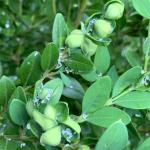
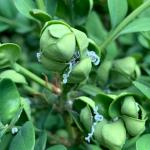 Severe infestation of the boxwood psyllid (Psylla buxi) on boxwood (Buxus sp.). The plant is mature (~20-years-old) and upright in form, growing in almost full shade within a small, east-facing foundation bed. Soils are compacted and no supplemental irrigation is provided. There is also a minor infestation of the boxwood leafminer (Monoarthropalpus flavus). The boxwood psyllid is a common insect pest on ornamental boxwood, typically causing only minor damage that does not threaten the long-term health of the plant. White-colored, waxy exudates can be observed during early season feeding, as shown in the photos here. Feeding by the psyllid causes leaves on the terminal shoots to curl but they often remain viable for the season.
Severe infestation of the boxwood psyllid (Psylla buxi) on boxwood (Buxus sp.). The plant is mature (~20-years-old) and upright in form, growing in almost full shade within a small, east-facing foundation bed. Soils are compacted and no supplemental irrigation is provided. There is also a minor infestation of the boxwood leafminer (Monoarthropalpus flavus). The boxwood psyllid is a common insect pest on ornamental boxwood, typically causing only minor damage that does not threaten the long-term health of the plant. White-colored, waxy exudates can be observed during early season feeding, as shown in the photos here. Feeding by the psyllid causes leaves on the terminal shoots to curl but they often remain viable for the season.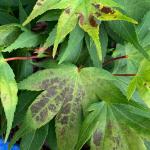 Sunscald on a dwarf Japanese maple (Acer palmatum ‘Mikawa Yatsubusa’). The plant is less than five-years-old and was transplanted from a one gallon pot into a ceramic container this spring. The potting media is high in organic matter and topped with a thick layer of bark mulch. The tree receives full sun and is watered regularly but over the past week, browning on internal portions of the youngest, outer canopy leaves developed. This dwarf cultivar has a very dense, overlapping canopy and while it can tolerate full sun, the abnormally warm conditions for late May proved too intense. The new leaves are yellow when they emerge, becoming green over time. The lack of chlorophyll in the young leaves made them more susceptible to injury. Young Japanese maples in containers can be prone to sunscald but should adapt over time.
Sunscald on a dwarf Japanese maple (Acer palmatum ‘Mikawa Yatsubusa’). The plant is less than five-years-old and was transplanted from a one gallon pot into a ceramic container this spring. The potting media is high in organic matter and topped with a thick layer of bark mulch. The tree receives full sun and is watered regularly but over the past week, browning on internal portions of the youngest, outer canopy leaves developed. This dwarf cultivar has a very dense, overlapping canopy and while it can tolerate full sun, the abnormally warm conditions for late May proved too intense. The new leaves are yellow when they emerge, becoming green over time. The lack of chlorophyll in the young leaves made them more susceptible to injury. Young Japanese maples in containers can be prone to sunscald but should adapt over time.- Stigmina needle cast (Stigmina lautii) and Phomopsis stem cankering (Phomopsis sp.) on Korean spruce (Picea koraiensis). The tree is 30-years-old and resides in full sun with well-drained, loam soils. The tree’s root collar was excavated four years ago due to deep planting. The interior canopy has suffered significant dieback but the new growth is healthy and robust. Stigmina was abundant on the submitted needles and there was no sign of Rhizosphaera, although it could present in other parts of the canopy. Phomopsis stem cankering is very common on stressed and weakened spruce, furthering the dieback initiated by the needle blight disease.
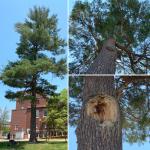
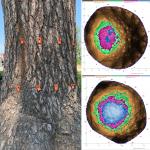 Lower trunk rot of eastern white pine (Pinus strobus). The tree has a height >80’ and dbh of 36” and resides in full sun with well-drained soils on the UMass campus. It has a single leader but some odd branching patterns throughout the canopy. The tree also has a large tear-out wound at the lowest point of the canopy. Two sets of sonic and electrical resistance tomography scans were captured from the lower trunk. The results revealed decay within the heartwood, encompassing ~40% of the cross-sectional area at the lower scanning height (~1.5’ above the soil line). The area of decay decreased to ~20% at the next scanning height (>3’ from the soil line). This mature white pine is being utilized by an MS student in arboriculture to test various tree risk assessment methods. Overall, this white pine is one of the largest and most unique within the campus core at UMass.
Lower trunk rot of eastern white pine (Pinus strobus). The tree has a height >80’ and dbh of 36” and resides in full sun with well-drained soils on the UMass campus. It has a single leader but some odd branching patterns throughout the canopy. The tree also has a large tear-out wound at the lowest point of the canopy. Two sets of sonic and electrical resistance tomography scans were captured from the lower trunk. The results revealed decay within the heartwood, encompassing ~40% of the cross-sectional area at the lower scanning height (~1.5’ above the soil line). The area of decay decreased to ~20% at the next scanning height (>3’ from the soil line). This mature white pine is being utilized by an MS student in arboriculture to test various tree risk assessment methods. Overall, this white pine is one of the largest and most unique within the campus core at UMass.
Report by Nick Brazee, Plant Pathologist, UMass Extension Plant Diagnostic Lab, UMass Amherst.
Insects
Upcoming Educational Programs:
Looking for more information about important arthropod vectors of human pathogens in Massachusetts? Don’t miss UMass Extension’s Tick and Mosquito Education Days!
June 8 & June 15 from 10:00 AM – 12:10 PM
This 2-day virtual webinar series will call upon topic experts to provide information about the seasonality, biology, and the diseases these organisms vector, as well as how to manage these pests and steps you can take to protect yourself.
June 8 – Tick Topics:
10:00 – 11:00 AM: Tick Management in the Landscape, Larry Dapsis, Cape Cod Cooperative Extension
11:10 AM – 12:10 PM: The Outreach Hiker’s Guide to Tick-ology: Personal tick bite prevention and more! Blake Dinius, Plymouth County Extension
June 15 – Mosquito Topics:
10:00 - 11:00 AM: Mosquitoes in Massachusetts, Arboviruses and Protecting Yourself, Dr. Jennifer Forman Orth, MA Dept. of Agricultural Resources
11:10 AM – 12:10 PM: Dealing With the Asian Tiger Mosquito: Incorporating an Invasive Species into an Existing Mosquito Control Program, Priscilla Matton, Superintendent, Bristol County Mosquito Control Project
For more information and to register, visit: https://ag.umass.edu/landscape/events/tick-mosquito-education-days
Really Cool Beneficial Insects in the Garden:
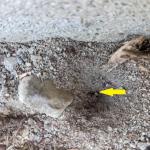
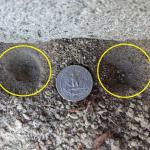
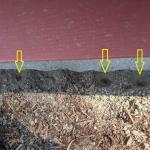 Antlions: These really cool insects are members of the Order Neuroptera (antlions, lacewings, mantispids, and owlflies) and in the Family Myrmeleontidae (antlions and owlflies). In general, the Neuroptera are medium-sized insects with four, many-veined wings as adults. They have complete metamorphosis, with egg, larva, pupa, and adult stages. Antlion larvae are sometimes referred to as “doodlebugs”, due to their pitfall-trap digging behavior. These voracious predators create their own pitfall traps in sandy soils, and lie-in-wait (hidden in the sand at the bottom of the pit) for ants and other suitable prey to fall in. Antlion larvae frequently make their funnel-shaped pits at the base of foundations in fine, dry soils. They may also be found under eaves or porches (areas that are protected from direct rainfall). While soil type may differ, it appears that they do require dry soils with fine texture. (If you are looking to attract antlions to your foundation planting, entomologists have suggested this may be done by pouring a thin layer of fine textured sand next to the foundation, beneath the eaves.) The larvae are peculiar in their appearance, with broad, flattened bodies, short legs used for crawling backward, and a flattened head with impressive sickle-shaped mandibles (mouthparts). Larvae look very different from the adult antlions, which are similar to a damselfly in appearance. Antlion larvae do not cause damage to plants, and should be preserved in gardens and landscapes. They are also fascinating insects to teach children about – adults and kids alike will enjoy watching an antlion attack and flick sand at a thin, stiff blade of grass used to prod the bottom of their pit. These insects blend in so well with the soil, do not be surprised if you only suddenly notice their large mandibles when they move!
Antlions: These really cool insects are members of the Order Neuroptera (antlions, lacewings, mantispids, and owlflies) and in the Family Myrmeleontidae (antlions and owlflies). In general, the Neuroptera are medium-sized insects with four, many-veined wings as adults. They have complete metamorphosis, with egg, larva, pupa, and adult stages. Antlion larvae are sometimes referred to as “doodlebugs”, due to their pitfall-trap digging behavior. These voracious predators create their own pitfall traps in sandy soils, and lie-in-wait (hidden in the sand at the bottom of the pit) for ants and other suitable prey to fall in. Antlion larvae frequently make their funnel-shaped pits at the base of foundations in fine, dry soils. They may also be found under eaves or porches (areas that are protected from direct rainfall). While soil type may differ, it appears that they do require dry soils with fine texture. (If you are looking to attract antlions to your foundation planting, entomologists have suggested this may be done by pouring a thin layer of fine textured sand next to the foundation, beneath the eaves.) The larvae are peculiar in their appearance, with broad, flattened bodies, short legs used for crawling backward, and a flattened head with impressive sickle-shaped mandibles (mouthparts). Larvae look very different from the adult antlions, which are similar to a damselfly in appearance. Antlion larvae do not cause damage to plants, and should be preserved in gardens and landscapes. They are also fascinating insects to teach children about – adults and kids alike will enjoy watching an antlion attack and flick sand at a thin, stiff blade of grass used to prod the bottom of their pit. These insects blend in so well with the soil, do not be surprised if you only suddenly notice their large mandibles when they move!
Insects and Other Arthropods of Medical Importance:
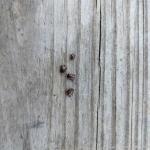
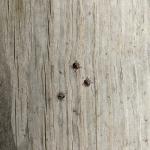 American Dog Tick: Anecdotally, Dermacentor variabilis adults are prevalent in certain locations of Massachusetts at this time. Reports from Cape Cod of adult dog ticks crawling on the siding of homes have been noted. Photographic evidence of adult dog ticks crawling up metal objects leaning against a home located in a heavily wooded area of Berkshire County, MA have also been reported recently (5/9/2021). The images shown here are adult stage dog ticks removed from a dog following a roadside walk in Hampshire County on both 5/6/21 (4 ticks removed) and 5/7/21 (3 ticks removed).
American Dog Tick: Anecdotally, Dermacentor variabilis adults are prevalent in certain locations of Massachusetts at this time. Reports from Cape Cod of adult dog ticks crawling on the siding of homes have been noted. Photographic evidence of adult dog ticks crawling up metal objects leaning against a home located in a heavily wooded area of Berkshire County, MA have also been reported recently (5/9/2021). The images shown here are adult stage dog ticks removed from a dog following a roadside walk in Hampshire County on both 5/6/21 (4 ticks removed) and 5/7/21 (3 ticks removed).
The American dog tick is found throughout most of North America. It may be encountered in forest edges, fields, along walkways and roadways, sidewalks, and trails. Adult stage ticks may be found on raccoons, skunks, cats, dogs, and other medium-sized hosts. Larvae and nymphs can be found on mice, voles, rats, and chipmunks. Adult males and females are active between April and early-August. Both adult males and females will feed, including on people. Nymphs and larvae of this species rarely attach to people or their pets. This species of tick can transmit lesser-known diseases such as Rocky Mountain Spotted Fever (not frequently infecting humans, according to CDC reports) and Tularemia (rarely infecting humans, according to CDC reports). For more information about the American dog tick, visit: https://web.uri.edu/tickencounter/species/dog-tick/ .
- Deer Tick/Blacklegged Tick: Check out the archived FREE TickTalk with TickReport webinars available here: https://ag.umass.edu/landscape/education-events/webinars .
*Ixodes scapularis adults are active, as they typically are from October through May, and “quest” or search for hosts at any point when daytime temperatures are above freezing. Engorged females survive the winter and will lay 1,500+ eggs in the forest leaf litter beginning around Memorial Day (late May). We are now entering the time of year when deer tick larvae and nymphs are frequently encountered. Larvae may be encountered in April, but in some locations may peak in their activity in August, while still being encountered through November. Nymphs are encountered from April through July, peaking in June. Nymphs are again present in October and November. For images of all deer tick life stages, along with an outline of the diseases they carry, and their timing of activity, visit: http://www.tickencounter.org/tick_identification/deer_tick .
Anyone working in the yard and garden should be aware that there is the potential to encounter deer ticks. The deer tick or blacklegged tick can transmit Lyme disease, human babesiosis, human anaplasmosis, and other diseases. Preventative activities, such as daily tick checks, wearing appropriate clothing, and permethrin treatments for clothing (according to label instructions) can aid in reducing the risk that a tick will become attached to your body. If a tick cannot attach and feed, it will not transmit disease. For more information about personal protective measures, visit: http://www.tickencounter.org/prevention/protect_yourself .
The Center for Agriculture, Food, and the Environment provides a list of potential tick identification and testing resources here: https://ag.umass.edu/resources/tick-testing-resources
*Note that deer ticks (Ixodes scapularis) are not the only disease-causing tick species found in Massachusetts. The American dog tick (Dermacentor variabilis) and the lone star tick (Amblyomma americanum) are also found throughout MA. Each can carry their own complement of diseases, including others not mentioned above. Anyone working or playing in tick habitats (wood-line areas, forested areas, and landscaped areas with ground cover) should check themselves regularly for ticks while practicing preventative measures.
- Mosquitoes: According to the Massachusetts Bureau of Infectious Disease and Laboratory Science and the Department of Public Health, there are at least 51 different species of mosquito found in Massachusetts. Mosquitoes belong to the Order Diptera (true flies) and the Family Culicidae (mosquitoes). As such, they undergo complete metamorphosis, and possess four major life stages: egg, larva, pupa, and adult. Adult mosquitoes are the only stage that flies and many female mosquitoes only live for 2 weeks (although the life cycle and timing will depend upon the species). Only female mosquitoes bite to take a blood meal, and this is so they can make eggs. Mosquitoes need water to lay their eggs in, so they are often found in wet or damp locations and around plants. Different species prefer different habitats. It is possible to be bitten by a mosquito at any time of the day, and again timing depends upon the species. Many are particularly active from just before dusk, through the night, and until dawn. Mosquito bites are not only itchy and annoying, but they can be associated with greater health risks. Certain mosquitoes vector pathogens that cause diseases such as West Nile virus (WNV) and eastern equine encephalitis (EEE).
For more information about mosquitoes in Massachusetts, visit: https://www.mass.gov/service-details/mosquitoes-in-massachusetts
There are ways to protect yourself against mosquitoes, including wearing long-sleeved shirts and long pants, keeping mosquitoes outside by using tight-fitting window and door screens, and using insect repellents as directed. Products containing the active ingredients DEET, permethrin, IR3535, picaridin, and oil of lemon eucalyptus provide protection against mosquitoes.
For more information about mosquito repellents, visit: https://www.mass.gov/service-details/mosquito-repellents and https://www.cdc.gov/mosquitoes/mosquito-bites/prevent-mosquito-bites.html .
- Wasps/Hornets: Many wasps are predators of other arthropods, including pest insects such as certain caterpillars that feed on trees and shrubs. Adult wasps hunt prey and bring it back to their nest where young are being reared, as food for the immature wasps. A common such example are the paper wasps (Polistes spp.) who rear their young on chewed up insects. They may be seen searching plants for caterpillars and other soft-bodied larvae to feed their young. Paper wasps can sting, and will defend their nests, which are open-celled paper nests that are not covered with a papery “envelope”. These open-celled nests may be seen hanging from eaves or other outdoor building structures. Aerial yellow jackets and hornets create large aerial nests that are covered with a papery shell or “envelope”. Common yellow jacket species include those in the genus Vespula. Dolichovespula maculata is commonly known as the baldfaced hornet, although it is not a true hornet. The European hornet (Vespa crabro) is three times the size of a yellow jacket and may be confused for the Asian giant hornet (Vespa mandarinia). The European hornet is known to Massachusetts, but the Asian giant hornet is not. If you are concerned that you have found or photographed an Asian giant hornet, please report it here: https://massnrc.org/pests/report.aspx . Paper wasps and aerial yellowjackets overwinter as fertilized females (queens) and a single female produces a new nest annually in the late spring. Nests are abandoned at the end of the season. Queens start new nests, lay eggs, and rear new wasps to assist in colony/nest development.Some people are allergic to stinging insects, so care should be taken around wasp/hornet nests. Unlike the European honeybee (Apis mellifera), wasps and hornets do not have barbed stingers, and therefore can sting repeatedly when defending their nests. It is best to avoid their nests, and if that cannot be done and assistance is needed to remove them, consult a professional.
Woody ornamental insect and non-insect arthropod pests to consider, a selected few:
Invasive Insects & Other Organisms Update:
- Spotted Lanternfly: (Lycorma delicatula, SLF) is not known to be established in Massachusetts landscapes at this time. However, due to the great ability of this insect to hitchhike using human-aided movement, it is important that we remain vigilant in Massachusetts and report any suspicious findings. Spotted lanternfly reports can be sent here: https://massnrc.org/pests/slfreport.aspx .
The Massachusetts Department of Agricultural Resources has recently released spotted lanternfly Best Management Practices for Nurseries and Landscapers: https://massnrc.org/pests/linkeddocuments/MANurseryBMPs.pdf
And Best Management Practices for Moving Companies and the Moving Industry: https://massnrc.org/pests/linkeddocuments/SLFChecklistMovingIndustryMA.pdf
Now is a great time to provide copies of these BMP’s to employees, customers, family, and friends! The more eyes we have out there looking for spotted lanternfly, the better. Use the above BMP’s as a guide to help you inspect certain items coming from CT, DE, MD, NC, NJ, NY, OH, PA, WV, and VA.
UMass Extension is teaming up with UMass Amherst’s Department of Environmental Conservation, the USDA APHIS, and the Massachusetts Department of Agricultural Resources to monitor for the spotted lanternfly in Massachusetts. A team including members of UMass Extension’s Landscape, Nursery, and Urban Forestry Program, Extension’s Fruit Program, Stockbridge School of Agriculture, and the Department of Environmental Conservation at UMass, Amherst are undertaking a nine-month integrated research and extension project to develop effective tools to detect the spotted lanternfly.
The researchers associated with this project (Dr. Joseph Elkinton, Dr. Jeremy Andersen and Dr. Jaime Pinero) will be working with Dr. Miriam Cooperband of the USDA APHIS lab on Cape Cod to identify and evaluate airborne attractants that can improve the ability to detect SLF in traps. Dr. Cooperband has identified several attractant lures released from host plants of SLF. She is currently working on pheromones produced by SLF that may be much more attractive. The UMass team will help her conduct field tests of these new lures, while also assisting the Massachusetts Department of Agricultural Resources (MDAR) in monitoring for SLF in Massachusetts. UMass Extension Entomologist, Tawny Simisky, will periodically report on progress made during the course of this project. For more information, please visit: https://ag.umass.edu/cafe/news/looking-for-spotted-lanternfly-recent-invasive-arrival
This insect is a member of the Order Hemiptera (true bugs, cicadas, hoppers, aphids, and others) and the Family Fulgoridae, also known as planthoppers. The spotted lanternfly is a non-native species first detected in the United States in Berks County, Pennsylvania and confirmed on September 22, 2014.
For a map of known, established populations of SLF as well as detections outside of these areas where individual finds of spotted lanternfly have occurred (but no infestations are present), visit: https://nysipm.cornell.edu/environment/invasive-species-exotic-pests/spotted-lanternfly/
The spotted lanternfly is considered native to China, India, and Vietnam. It has been introduced as a non-native insect to South Korea and Japan, prior to its detection in the United States. In South Korea, it is considered invasive and a pest of grapes and peaches. The spotted lanternfly has been reported feeding on over 103 species of plants, according to new research (Barringer and Ciafré, 2020) and when including not only plants on which the insect feeds, but those that it will lay egg masses on, this number rises to 172. This includes, but is not limited to, the following: tree of heaven (Ailanthus altissima) (preferred host), apple (Malus spp.), plum, cherry, peach, apricot (Prunus spp.), grape (Vitis spp.), pine (Pinus spp.), pignut hickory (Carya glabra), sassafras (Sassafras albidum), serviceberry (Amelanchier spp.), slippery elm (Ulmus rubra), tulip poplar (Liriodendron tulipifera), white ash (Fraxinus americana), willow (Salix spp.), American beech (Fagus grandifolia), American linden (Tilia americana), American sycamore (Platanus occidentalis), big-toothed aspen (Populus grandidentata), black birch (Betula lenta), black cherry (Prunus serotina), black gum (Nyssa sylvatica), black walnut (Juglans nigra), dogwood (Cornus spp.), Japanese snowbell (Styrax japonicus), maple (Acer spp.), oak (Quercus spp.), and paper birch (Betula papyrifera).
The adults and immatures of this species damage host plants by feeding on sap from stems, leaves, and the trunks of trees. In the springtime in Pennsylvania (late April - mid-May) nymphs (immatures) are found on smaller plants and vines and new growth of trees and shrubs. Third and fourth instar nymphs migrate to the tree of heaven and are observed feeding on trunks and branches. Trees may be found with sap weeping from the wounds caused by the insect’s feeding. The sugary secretions (excrement) created by this insect may coat the host plant, later leading to the growth of sooty mold. Insects such as wasps, hornets, bees, and ants may also be attracted to the sugary waste created by the lanternflies, or sap weeping from open wounds in the host plant. Host plants have been described as giving off a fermented odor when this insect is present.
Adults are present by the middle of July in Pennsylvania and begin laying eggs by late September and continue laying eggs through late November and even early December in that state. Adults may be found on the trunks of trees such as the tree of heaven or other host plants growing in close proximity to them. Egg masses of this insect are gray in color and look similar in some ways to gypsy moth egg masses.
Host plants, bricks, stone, lawn furniture, recreational vehicles, and other smooth surfaces can be inspected for egg masses. Egg masses laid on outdoor residential items such as those listed above may pose the greatest threat for spreading this insect via human aided movement.
For more information about the spotted lanternfly, visit this fact sheet: https://ag.umass.edu/landscape/fact-sheets/spotted-lanternfly .
- Emerald Ash Borer: (Agrilus planipennis, EAB) Since the New Year, the Massachusetts Department of Conservation and Recreation has confirmed at least 22 new community detections of emerald ash borer in Massachusetts. To date, 11 out of the 14 counties in Massachusetts have confirmed emerald ash borer. (The remaining counties where EAB has yet to be detected are Barnstable, Dukes, and Nantucket counties.)A map of these locations and others previously known across the state may be found here: https://ag.umass.edu/fact-sheets/emerald-ash-borer .
This wood-boring beetle readily attacks ash (Fraxinus spp.) including white, green, and black ash and has also been found developing in white fringe tree (Chionanthus virginicus) and has been reported in cultivated olive (Olea europaea). Adult insects of this species will not be present at this time of year. Signs of an EAB infested tree may include (at this time) D-shaped exit holes in the bark (from adult emergence in previous years), “blonding” or lighter coloration of the ash bark from woodpecker feeding (chipping away of the bark as they search for larvae beneath), and serpentine galleries visible through splits in the bark, from larval feeding beneath. It is interesting to note that woodpeckers are capable of eating 30-95% of the emerald ash borer larvae found in a single tree (Murphy et al. 2018). Unfortunately, despite high predation rates, EAB populations continue to grow.
For further information about this insect, please visit: https://ag.umass.edu/fact-sheets/emerald-ash-borer . If you believe you have located EAB-infested ash trees, particularly in an area of Massachusetts not identified on the map provided, please report here: https://massnrc.org/pests/eabreport.htm .
- Winter Moth: (Operophtera brumata) data since 2017 has indicated that the winter moth population in eastern Massachusetts has been on the decline while the percent of winter moth pupae parasitized by Cyzenis albicans has increased! This is excellent news, as it is data supporting the evidence that winter moth populations have decreased while the parasitic fly, C. albicans, has become established at many locations in New England. Dr. Joseph Elkinton’s laboratory at UMass Amherst has released this biological control of winter moth since 2005 and conducted the rigorous sampling required to determine where the insect has established and what its impact on the winter moth population has been at multiple sites in eastern MA. More information about the Elkinton Lab’s research and the biological control of winter moth can be found here: https://www.fs.fed.us/foresthealth/technology/pdfs/FHAAST-2018-03_Biology_Control_Winter-Moth.pdf
The take-home point? Do not worry about winter moth this year! In fact, management of this insect in landscaped settings will likely not be necessary in most locations. In recent years, it is worth-while to note that some areas on the Cape and other locations in eastern MA have reported noticeable cankerworm populations in the spring, which are often confused for winter moth. Read more about cankerworms below.
For blueberry growers in eastern Massachusetts concerned about winter moth, please visit this update from Heather Faubert, University of Rhode Island: https://web.uri.edu/ipm/2021/04/april-22-winter-moth-update/ .
- Gypsy Moth:(Lymantria dispar) thanks to the gypsy moth caterpillar killing fungus, Entomophaga maimaiga, the recent outbreak of gypsy moth in Massachusetts has come to an end! Most locations in Massachusetts will not see damaging or even noticeable populations of this insect in 2021. However, there have been recent reports of young gypsy moth caterpillars feeding on susceptible hosts. While this may be the case in certain locations, we do not expect widespread defoliation from this insect in 2021. Gypsy moth has been in Massachusetts since the 1860's. This invasive insect from Europe often goes unnoticed, thanks to population regulation provided by the entomopathogenic fungus, E. maimaiga, as well as a NPV virus specific to gypsy moth caterpillars. (And to a lesser extent many other organisms, including other insects, small mammals, and birds who feed on gypsy moth.) However, if environmental conditions do not favor the life cycle of the fungus, outbreaks of gypsy moth caterpillars are possible. (Such as most recently from 2015-2018, with a peak in the gypsy moth population in 2017 in Massachusetts.)
Check out Episode 1 of InsectXaminer to reminisce about the 2015-2018 outbreak of this insect: https://ag.umass.edu/landscape/education-events/insectxaminer
- Asian Longhorned Beetle: (Anoplophora glabripennis, ALB) Look for signs of an ALB infestation which include perfectly round exit holes (about the size of a dime), shallow oval or round scars in the bark where a female has chewed an egg site, or sawdust-like frass (excrement) on the ground nearby host trees or caught in between branches. Be advised that other, native insects may create perfectly round exit holes or sawdust-like frass, which can be confused with signs of ALB activity.
The regulated area for Asian longhorned beetle is 110 miles2 encompassing Worcester, Shrewsbury, Boylston, West Boylston, and parts of Holden and Auburn. If you believe you have seen damage caused by this insect, such as exit holes or egg sites, on susceptible host trees like maple, please call the Asian Longhorned Beetle Eradication Program office in Worcester, MA at 508-852-8090 or toll free at 1-866-702-9938.
To report an Asian longhorned beetle find online or compare it to common insect look-alikes, visit: http://massnrc.org/pests/albreport.aspx or https://www.aphis.usda.gov/pests-diseases/alb/report .
- White Spotted Pine Sawyer (WSPS): Monochamus scutellatus adults can emerge in late May throughout July, depending on local temperatures. This is a native insect in Massachusetts and is usually not a pest. Larvae develop in weakened or recently dead conifers, particularly eastern white pine (Pinus strobus). However, the white spotted pine sawyer looks very similar to the invasive Asian Longhorned Beetle, Anoplophora glabripennis, ALB. ALB adults do not emerge in Massachusetts until July and August. Beginning in July, look for the key difference between WSPS and ALB adults, which is a white spot in the top center of the wing covers (the scutellum) on the back of the beetle. White spotted pine sawyer will have this white spot, whereas Asian longhorned beetle will not. Both insects can have other white spots on the rest of their wing covers; however, the difference in the color of the scutellum is a key characteristic. See the Asian longhorned beetle entry above for more information about that non-native insect.
- Jumping Worms: In recent years, public concern about Amynthas spp. earthworms, collectively referred to as “jumping or crazy or snake” worms, has dramatically increased. University researchers and Extension groups in many locations in the US are finding that these species cause not only forest ecosystem disturbances, but may also negatively impact soil structure and reduce plant growth in gardens and managed landscapes. They do this by voraciously devouring the organic layer of the soil while feeding very close to the soil surface, unlike other species of earthworms. In woodland areas, they can quickly eat all of the leaf litter on the forest floor. Jumping worms also leave a distinct grainy soil full of worm castings. The soil becomes granular and may look like dried coffee grounds.
Unfortunately, there are currently no research-based management options available for these earthworms. So prevention is essential – preventing their introduction and spread into new areas is the best defense against them. Adult jumping worms can be 1.5 – 8 inches or more in length. Their clitellum (collar-like ring) is roughly located 1/3 down the length of the worm (from the head) and is smooth and cloudy-white and constricted. These worms may also wiggle or jump when disturbed, and can move across the ground in an S-shape like a snake. While the exact timing of their life cycle in MA might not be completely understood, their life cycle may be expected to go (roughly) something like this: they hatch in the late spring in 1-4 inches of soil, mature into adults during the summer and adults lay eggs sometime in August, and it is thought that their cocoons overwinter. (Adults perish with frost.) It is also worth noting here that jumping worms do not directly harm humans or pets.
For more information, listen to Dr. Olga Kostromytska’s presentation here: https://ag.umass.edu/landscape/education-events/invasive-insect-webinars
Suggested reading includes Dr. Kostromytska’s recent “Hot Topics” article in Hort Notes (including an identification guide), here: https://ag.umass.edu/landscape/newsletters/hort-notes/hort-notes-2021-vol-323
Additional resources can also be found here:
University of Minnesota Extension: https://extension.umn.edu/identify-invasive-species/jumping-worms
Cornell Cooperative Extension: http://ulster.cce.cornell.edu/environment/invasive-pests/jumping-worm
UNH Extension: https://extension.unh.edu/blog/invasive-spotlight-jumping-worms
Tree & Shrub Insects & Mites:
- Arborvitae Leafminer: In New England and eastern Canada, four species of leafminers are known to infest arborvitae. These include Argyresthia thuiella, A. freyella, A. aureoargentella, and Coleotechnites thujaella. The arborvitae leafminer, A. thuiella, is the most abundant of these and has the greatest known range when compared to the others. (It is also found in the Mid-Atlantic States and as far west as Missouri). Moths of this species appear from mid-June to mid-July and lay their eggs. The damage caused by all of these species is nearly identical. Trees, however, have been reported to lose up to 80% of their foliage due to arborvitae leafminer and still survive. At least 27 species of parasites have been reported as natural enemies of arborvitae leafminers, the most significant of which may be a parasitic wasp (Pentacnemus bucculatricis). Arborvitae leafminer damage causes the tips of shoots and foliage to turn yellow and brown. If infestations are light, prune out infested tips.

 Azalea Sawflies: There are a few species of sawflies that impact azaleas. Johnson and Lyon's Insects that Feed on Trees and Shrubs mentions three of them. Amauronematus azaleae was first reported in New Hampshire in 1895 and is likely found in most of New England. Adults of this species are black with some white markings and wasp-like. Generally green larvae feed mostly on mollis hybrid azaleas. Remember, sawfly caterpillars have at least enough abdominal prolegs to spell “sawfly” (so 6 or more prolegs). Adults are present in May, and females lay their eggs and then larvae hatch and feed through the end of June. There is one generation per year. Nematus lipovskyi has been reared from swamp azalea (Rhododendron viscosum). Adults of that species have been collected in April (in states to the south) and May (in New England) and larval feeding is predominantly in late April and May in Virginia and June in New England. One generation of this species occurs per year, and most mollis hybrid azaleas can be impacted. A third species, Arge clavicornis, is found as an adult in July and lays its eggs in leaf edges in rows. Larvae are present in August and September. Remember, Bacillus thuringiensis Kurstaki does not manage sawflies.
Azalea Sawflies: There are a few species of sawflies that impact azaleas. Johnson and Lyon's Insects that Feed on Trees and Shrubs mentions three of them. Amauronematus azaleae was first reported in New Hampshire in 1895 and is likely found in most of New England. Adults of this species are black with some white markings and wasp-like. Generally green larvae feed mostly on mollis hybrid azaleas. Remember, sawfly caterpillars have at least enough abdominal prolegs to spell “sawfly” (so 6 or more prolegs). Adults are present in May, and females lay their eggs and then larvae hatch and feed through the end of June. There is one generation per year. Nematus lipovskyi has been reared from swamp azalea (Rhododendron viscosum). Adults of that species have been collected in April (in states to the south) and May (in New England) and larval feeding is predominantly in late April and May in Virginia and June in New England. One generation of this species occurs per year, and most mollis hybrid azaleas can be impacted. A third species, Arge clavicornis, is found as an adult in July and lays its eggs in leaf edges in rows. Larvae are present in August and September. Remember, Bacillus thuringiensis Kurstaki does not manage sawflies.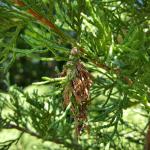 Bagworm: Thyridopteryx ephemeraeformis is a native species of moth whose larvae construct bag-like coverings over themselves with host plant leaves and twigs. This insect overwinters in the egg stage, within the bags of deceased females from last season. Eggs may hatch and young larvae are observed feeding around mid-June, or roughly between 600-900 GDD’s. Now is the time to scout for and remove and destroy any overwintered bags. In certain areas across MA in 2020, increased populations of bagworms were observed and reported, particularly in urban forest settings and managed landscapes. More information can be found here: https://ag.umass.edu/landscape/fact-sheets/bagworm
Bagworm: Thyridopteryx ephemeraeformis is a native species of moth whose larvae construct bag-like coverings over themselves with host plant leaves and twigs. This insect overwinters in the egg stage, within the bags of deceased females from last season. Eggs may hatch and young larvae are observed feeding around mid-June, or roughly between 600-900 GDD’s. Now is the time to scout for and remove and destroy any overwintered bags. In certain areas across MA in 2020, increased populations of bagworms were observed and reported, particularly in urban forest settings and managed landscapes. More information can be found here: https://ag.umass.edu/landscape/fact-sheets/bagworm- Boxwood Leafminer: Monarthropalpus flavus partly grown fly larvae overwinter in the leaves of susceptible boxwood. Yellowish mines may be noticeable on the undersides of leaves. This insect grows rapidly in the spring, transforming into an orange-colored pupa. After pupation, adults will emerge and white colored pupal cases may hang down from the underside of leaves where adults have emerged. Adults may be observed swarming hosts between 300-650 GDD’s, or roughly the end of May through June. Most cultivars of Buxus sempervirens and B. microphylla are thought to be susceptible. If installing new boxwoods this spring, resistant cultivars such as ‘Vardar Valley’ and ‘Handsworthiensis’ are good choices at sites where this insect has been a problem.
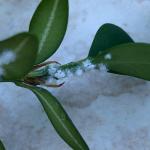
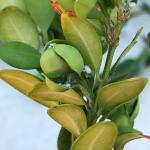 Boxwood Psyllid: Psylla buxi feeding can cause cupping of susceptible boxwood leaves. Leaf symptoms/damage may remain on plants for up to two years. English boxwood may be less severely impacted by this pest. Eggs overwinter, buried in budscales, and hatch around budbreak of boxwood. Eggs may hatch around 80 GDD’s. Foliar applications may be made between 290-440 GDD’s. However, the damage caused by this insect is mostly aesthetic. Therefore, no management may be necessary.
Boxwood Psyllid: Psylla buxi feeding can cause cupping of susceptible boxwood leaves. Leaf symptoms/damage may remain on plants for up to two years. English boxwood may be less severely impacted by this pest. Eggs overwinter, buried in budscales, and hatch around budbreak of boxwood. Eggs may hatch around 80 GDD’s. Foliar applications may be made between 290-440 GDD’s. However, the damage caused by this insect is mostly aesthetic. Therefore, no management may be necessary.- Cankerworms: Alsophila pometaria (fall cankerworm) and Paleacrita vernata (spring cankerworm) are often confused for winter moth (Operophtera brumata). Cankerworm populations in eastern MA, particularly on areas of Cape Cod, were confused for winter moth in 2019. Spring cankerworm adults are active in February and March, and fall cankerworm adults are active in late November into early December. During these times, both species lay eggs. These native insects most commonly utilize elm, apple, oak, linden, and beech. Eggs of both species hatch as soon as buds begin to open in the spring. Caterpillars occur in mixed populations and are often noticeable by mid-May in MA. Young larvae will feed on buds and unfolding leaves. There are two color forms (light green and dark) for caterpillars of both species. Like winter moth, they will drop to the soil to pupate. This usually occurs in June. Fall cankerworm larvae have three pairs of prolegs (one of which is small so it is sometimes referred to as ½) and spring cankerworm have two pairs. (Winter moth caterpillars also have 2 pairs of prolegs.) If populations are large and damage is noticeable on hosts, reduced risk insecticides such as Bacillus thuringiensis Kurstaki or spinosad may target larvae between 148-290 GDD’s.
- Dogwood Borer: Synanthedon scitula is a species of clearwing moth whose larvae bore not only into dogwood (Cornus), but hosts also include flowering cherry, chestnut, apple, mountain ash, hickory, pecan, willow, birch, bayberry, oak, hazel, myrtle, and others. Kousa dogwood appear to be resistant to this species. Signs include the sloughing of loose bark, brown frass, particularly near bark cracks and wounds, dead branches, and adventitious growth. The timing of adult emergence can be expected when dogwood flower petals are dropping and weigela begins to bloom. Adult moth flights continue from then until September. Emergence in some hosts (ex. apple) appears to be delayed, but this differs depending upon the location in this insect’s range. Eggs are laid singly, or in small groups, on smooth and rough bark. Female moths preferentially lay eggs near wounded bark. After hatch, larvae wander until they find a suitable entrance point into the bark. This includes wounds, scars, or branch crotches. This insect may also be found in twig galls caused by other insects or fungi. Larvae feed on phloem and cambium. Fully grown larvae are white with a light brown head and approx. ½ inch long. Pheromone traps and lures are useful for determining the timing of adult moth emergence and subsequent management.
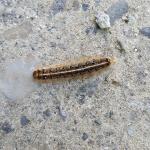 Eastern Tent Caterpillar: Malacosoma americanum eggs overwinter on host plant twigs. Egg hatch typically occurs when wild cherry leaves begin to unfold and young caterpillars may emerge by late-April through the first two weeks in May (90-190 GDD’s). Susceptible hosts include cherry and crabapple. Other host plants whose leaves are fed upon by this native insect can include apple, ash, birch, willow, maple, oak, poplar, and witch-hazel. Prune off and remove egg masses from ornamental host plants by early spring. Eastern tent caterpillars are native to Massachusetts and have many associated natural enemies (parasites and predators) that help regulate populations. Unless these caterpillars are actively defoliating specimen trees in a landscaped setting, we can coexist with this particular herbivore native to our forests.
Eastern Tent Caterpillar: Malacosoma americanum eggs overwinter on host plant twigs. Egg hatch typically occurs when wild cherry leaves begin to unfold and young caterpillars may emerge by late-April through the first two weeks in May (90-190 GDD’s). Susceptible hosts include cherry and crabapple. Other host plants whose leaves are fed upon by this native insect can include apple, ash, birch, willow, maple, oak, poplar, and witch-hazel. Prune off and remove egg masses from ornamental host plants by early spring. Eastern tent caterpillars are native to Massachusetts and have many associated natural enemies (parasites and predators) that help regulate populations. Unless these caterpillars are actively defoliating specimen trees in a landscaped setting, we can coexist with this particular herbivore native to our forests.- Elongate Hemlock Scale: Fiorinia externa is found on eastern, Carolina, and Japanese hemlock, as well as yew, spruce, and fir. The elongate hemlock scale may overwinter in various life stages, and overlap of many developmental stages at any given time can be observed throughout much of the season. Treatments for the crawler, or mobile, stage of this insect may be made in late May through mid-June, or between 360-700 GDD’s, base 50°F. Nitrogen fertilizer applications may make elongate hemlock scale infestations worse.
- Euonymus Caterpillar: Yponomeuta cagnagella is of European origin and widespread in distribution throughout Europe. It was first reported in North America in Ontario in 1967. The euonymus caterpillars (larvae) feed in groups and envelop the foliage of the host plant in webs as they feed. Hosts include: Euonymus europaeus (tree form), E. kiautschovicus, E. alatus, and E. japonicus. Mature caterpillars are just under an inch in length, creamy yellow-gray in color with black spots and a black head capsule. By late June, these larvae pupate in white, oval-shaped cocoons which are typically oriented together vertically either on host plants or non-hosts in the area. Cocoons can be found in cracks and crevices, or webbed together leaves. The adult moth emerges in late June in most locations. The adult female secretes a gummy substance over her eggs which will harden, making them even more difficult to see. Eggs hatch by mid-August, at which time the tiny larvae prepare to overwinter beneath their eggshell-like covering. These larvae are inactive until the following year, when caterpillars group together to feed on newly emerging leaves, creating a mess of webs as they feed. There is one generation per year. Plants may be partially or entirely defoliated. Management of young, actively feeding caterpillars with Bacillus thuringiensis is possible if deemed necessary, however many species of Euonymus are considered invasive themselves.
Check out Episode 3 of InsectXaminer to see the euonymus caterpillar in action and learn more about its life cycle: https://ag.umass.edu/landscape/education-events/insectxaminer
- Euonymus Scale: Unaspis euonymi is an armored scale that can be found on euonymus, holly, bittersweet, and pachysandra. This insect can cause yellow spotting on leaves, dieback, and distorted bark. For crawlers, early June timing is suggested between 533-820 GDD’s. (Eggs begin to hatch in early June.)
- European Pine Sawfly: Neodiprion sertifer overwinters in the egg stage. Eggs are laid by females the previous season by cutting slits in needles using their ovipositors and depositing 6-8 eggs in each of 10-12 needles. Egg hatch occurs from late-April to mid-May and caterpillars become active roughly between 78-220 GDD, base 50°F. The primary host in MA is Mugo pine but it can be found on Scots, red, jack, and Japanese red pine. It is also found on white, Austrian, ponderosa, shortleaf, and pitch pine when planted near the aforementioned species. This dark colored caterpillar feeds in tight groups and small numbers can be pruned or plucked out of host plants and destroyed. Spinosad products can be used whenever the caterpillars are actively feeding, usually by mid-May and when caterpillars are still small. Bacillus thuringiensis kurstaki is not effective against sawflies.
- Fletcher Scale: Parthenolecanium fletcheri is a soft scale pest of yew, juniper, and arborvitae. Feeding scales, especially on yew, result in honeydew and sooty mold, needle yellowing, and at times, premature needle drop. There is one generation per year. Overwintered second instar nymphs can be targeted between 38-148 GDD’s, base 50°F. Nymphs develop and adult females lay eggs (on average 500-600) in May that hatch by June. Dead females conceal egg masses beneath. Crawlers migrate short distances to branches and may be concentrated on certain branches of a particular plant.
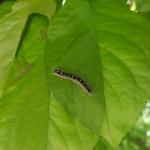 Forest Tent Caterpillar: Malacosoma disstria egg hatch occurs between 192-363 GDD’s, base 50°F, by mid-late May and caterpillars may be active for at least 5-6 weeks following. Susceptible hosts whose leaves are fed on by this insect include oak, birch, ash, maple, elm, poplar, and basswood. This native insect has many natural enemies, including some very effective pathogens that typically regulate populations. However, outbreaks of this insect can occur on occasion.
Forest Tent Caterpillar: Malacosoma disstria egg hatch occurs between 192-363 GDD’s, base 50°F, by mid-late May and caterpillars may be active for at least 5-6 weeks following. Susceptible hosts whose leaves are fed on by this insect include oak, birch, ash, maple, elm, poplar, and basswood. This native insect has many natural enemies, including some very effective pathogens that typically regulate populations. However, outbreaks of this insect can occur on occasion.- Hemlock Looper: Two species of geometrid moths in the genus Lambdina are native insects capable of defoliating eastern hemlock, balsam fir, and white spruce. Adult moths lay their eggs on the trunk and limbs of hosts in September and October, and eggs will hatch by late May or early June. (L. fiscellaria caterpillars may be active between 448-707 GDD’s.) Monitor susceptible hosts for small, inch-worm like caterpillars. Where populations are low, no management is necessary. Hemlock loopers have several effective natural enemies.
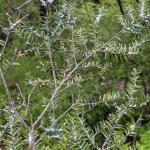
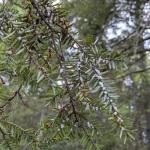 Hemlock Woolly Adelgid: Adelges tsugae is present on eastern and Carolina hemlock. The overwintering hemlock woolly adelgid generation (sistens) is present through mid-spring and produces the spring generation (progrediens) which will be present from early spring through mid-summer. HWA, unlike many other insects, does most of its feeding over the winter. Eggs may be found in woolly masses at the base of hemlock needles beginning in mid-March. Each woolly mass is created by a female who may then lay 50-300 eggs. Eggs hatch and crawlers may be found from mid-March through mid-July. Infested trees may be treated with foliar sprays in late April to early May, using Japanese quince as a phenological indicator. Systemic applications may be made in the spring and fall, or when soil conditions are favorable for translocation to foliage. Nitrogen fertilizer applications may make hemlock woolly adelgid infestations worse.
Hemlock Woolly Adelgid: Adelges tsugae is present on eastern and Carolina hemlock. The overwintering hemlock woolly adelgid generation (sistens) is present through mid-spring and produces the spring generation (progrediens) which will be present from early spring through mid-summer. HWA, unlike many other insects, does most of its feeding over the winter. Eggs may be found in woolly masses at the base of hemlock needles beginning in mid-March. Each woolly mass is created by a female who may then lay 50-300 eggs. Eggs hatch and crawlers may be found from mid-March through mid-July. Infested trees may be treated with foliar sprays in late April to early May, using Japanese quince as a phenological indicator. Systemic applications may be made in the spring and fall, or when soil conditions are favorable for translocation to foliage. Nitrogen fertilizer applications may make hemlock woolly adelgid infestations worse.- Holly Leafminers: Seven species of leaf miners feed on holly. Phytomyza ilicicola is usually referred to as the native holly leafminer. This species is known to feed on Ilex opaca, I. crenata, and related cultivars; however, it only lays its eggs in American holly (Ilex opaca). Some research suggests that the native holly leafminer may lay its eggs in other Ilex species, but that the larvae are unable to complete their development. This insect is found throughout the native range of its host plants. Larvae overwinter in leaf mines and pupation occurs in March and April and adult emergence by mid-May (192-298 GDD’s, base 50°F). Adult flies are known to emerge over a period of 6 or so weeks in the spring. Females lay eggs using their ovipositor on the underside of newly formed leaves. A tiny green blister forms on the leaf as the first symptom of injury. Larvae hatch from the egg and create a narrow mine that may appear brown from the upper leaf surface. Mines are broadened in the fall and a large blotch is completed in the winter. Larvae are yellow maggots and reach 1.5 mm. in length when mature. Current year’s mines are easily overlooked due to the slow feeding patterns of the larvae. Premature leaf drop may occur. Remove and destroy mined leaves before May. Phytomyza ilicis is usually only referred to as the holly leafminer, and it is a non-native species introduced from Europe and only feeds on Ilex aquifolium. (The native holly leaf miner does not develop in I. aquifolium.) The biology and damage this insect causes is similar to that of the native holly leafminer, with the exception of the fact that eggs are laid in the midvein of the leaf and young larvae tunnel in the vein until the fall. Remove and destroy mined leaves before May. Adults may be present mid-late May (246-448 GDD’s, base 50°F).
- Honeylocust Plant Bug: Diaphnocoris chlorionis feeding results in tiny yellowish-brownish spots on leaves, leaf distortion, and in some cases, defoliation. (There are at least 7 species of plant bugs that feed on honeylocust, Gleditsia triacanthos.) There is one generation per year. Immatures and adults feed on foliage and light to moderately damaged foliage may persist throughout the growing season. Honeylocust plant bugs overwinter as eggs laid just beneath the bark surface of 2 and 3 year old twigs. Eggs hatch just after vegetative buds of the host begin to open. Young nymphs crawl to the opening leaflets and begin feeding and the most significant damage occurs at that time, when the insect is hidden from view. Nymphs develop into adults around May-July. This insect can be targeted between 58-246 GDD’s, base 50°F.
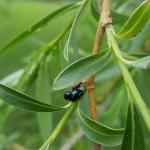
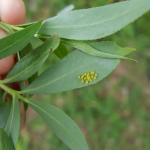 Imported Willow Leaf Beetle: Plagiodera versicolora adult beetles overwinter near susceptible hosts. Adult beetles will chew holes and notches in the leaves of willow once they become available. Females lay yellow eggs in clusters on the undersides of leaves. Larvae are slug-like and bluish-green in color. They will feed in clusters and skeletonize the leaves. Most plants can tolerate the feeding from this insect, and foliage will appear brown. Repeated yearly feeding can be an issue, in which case management of the young larvae may be necessary. Take care with treatment in areas near water.
Imported Willow Leaf Beetle: Plagiodera versicolora adult beetles overwinter near susceptible hosts. Adult beetles will chew holes and notches in the leaves of willow once they become available. Females lay yellow eggs in clusters on the undersides of leaves. Larvae are slug-like and bluish-green in color. They will feed in clusters and skeletonize the leaves. Most plants can tolerate the feeding from this insect, and foliage will appear brown. Repeated yearly feeding can be an issue, in which case management of the young larvae may be necessary. Take care with treatment in areas near water.
Check out Episode 4 of InsectXaminer to see the imported willow leaf beetle in action and learn more about its life cycle: https://ag.umass.edu/landscape/education-events/insectxaminer
- Lacebugs: Stephanitis spp. lacebugs such as S. pyriodes can cause severe injury to azalea foliage. S. rhododendri can be common on rhododendron and mountain laurel. S. takeyai has been found developing on Japanese andromeda, leucothoe, styrax, and willow. Stephanitis spp. lace bug activity should be monitored through September. Before populations become too large, treat with a summer rate horticultural oil spray as needed. Be sure to target the undersides of the foliage in order to get proper coverage of the insects. Certain azalea and andromeda cultivars may be less preferred by lace bugs.
- Lecanium Scales (Oak): Parthenolecanium quercifex overwinters as a second instar nymph on oak twigs. Females feed and mature in the spring, from mid-April to early May and eggs may be laid between late May and into June. Eggs hatch in June or early July and crawlers migrate to host plant leaves where they spend the summer and migrate as second instars back to host plant twigs in the fall.
- Lilac Borer: Podosesia syringae is a clearwing moth pest of lilac, privet, fringetree, and ash. (It is also known as the ash borer, not to be confused with the emerald ash borer.) Adults mimic paper wasps. Larvae are wood-boring, and signs and symptoms include branch dieback, holes, and occasionally, sawdust-like frass accumulated on bark. Larvae bore into stems, trunks, and branches, chewing an irregularly shaped entrance hole. Peak adult moth flights may occur in the northern portion of this insect’s range in June and is usually over by August 1st. Pheromone traps can be used to time adult emergence. Adult females lay flattened, oval, and tan eggs that are deposited singly or in clusters on bark crevices, ridges, and sometimes smooth bark; but usually laid in or near wounds in the bark. On average, 395 eggs are laid by each female. After hatch, larvae chew into the bark and feed laterally and then vertically in phloem tissue. Larvae overwinter in tunnels in the final instar and resume feeding in the spring. Adults emerge through a round exit hole (4-5 mm. in diameter). This insectmay be targeted between 200-299 GDD’s, base 50°F.
- Lily Leaf Beetle: Lilioceris lilii adults overwinter in sheltered places. As soon as susceptible hosts such as Lilium spp. (Turk’s cap, tiger, Easter, Asiatic, and Oriental lilies) and Fritillaria spp. break through the ground, the adult lily leaf beetles are known to feed on the new foliage. (Note: daylilies are not hosts.) Typically, in May, mating will occur and each female will begin to lay 250-450 eggs in neat rows on the underside of the foliage. If there are only a few plants in the garden, hand picking and destroying overwintering adults can help reduce local garden-level populations at that time.
Check out Episode 3 of InsectXaminer to see the lily leaf beetle in action and learn more about its life cycle: https://ag.umass.edu/landscape/education-events/insectxaminer
- Magnolia Scale: Neolecanium cornuparvum overwinters as first instar nymphs which are elliptical, and dark slate gray in color and can usually be found on the undersides of 1 and 2 year old twigs. Nymphs may molt by late April or May and again by early June at which time the scales may be purple in color. Eventually nymphs secrete a white powdery layer of wax over their bodies.
- Rhododendron Borer: Synanthedon rhododendri is one of the smallest of the native clearwing moths. Rhododendrons are preferred hosts, although mountain laurel, and deciduous azaleas can be heavily infested, especially if they are planted in close proximity to rhododendrons. Injury may be first noticed in the fall (leaves lose their sheen, then become pale green, then olive, then chlorotic) and can look similar to drought stress. On branches that seem to be stunted, look at limb crotches, scars, and other irregularities for sawdust stuck on bark or on the ground beneath these areas. In late May and early June, holes may contain pupal shed skins extending halfway out. Moth emergence occurs in the late-spring, early-summer. After mating, female moths seek out suitable egg laying locations (preferring wounded areas or limb crotches). The female lays her eggs and dies. Eggs hatch and larvae tunnel into the inner bark where they feed in tunnels that become packed with reddish frass pellets. By late fall, larvae move to the sapwood where they overwinter and resume feeding by mid-March. Pupation occurs in the spring and there is one generation per year. Prune out and destroy infested branches before late May/June. Monitor for adults in mid-May (192-298 GDD’s, base 50°F).
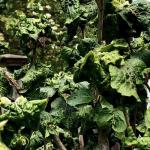
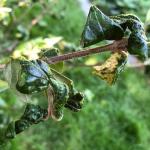 Snowball Aphid: Neoceruraphis viburnicola eggs overwinter on viburnum twigs and buds. Eggs hatch and this aphid becomes active on certain species of viburnum roughly between 148-298 GDD’s or around redbud bloom. This insect is particularly noticeable on V. opulus, V. prunifolium, and V. acerifolia. Stem mothers, appearing blueish-white, can be found in curled up and distorted foliage. Damage caused by this insect pest is mostly aesthetic. At this time, the damage from this insect has already occurred, so management for this season is no longer possible.
Snowball Aphid: Neoceruraphis viburnicola eggs overwinter on viburnum twigs and buds. Eggs hatch and this aphid becomes active on certain species of viburnum roughly between 148-298 GDD’s or around redbud bloom. This insect is particularly noticeable on V. opulus, V. prunifolium, and V. acerifolia. Stem mothers, appearing blueish-white, can be found in curled up and distorted foliage. Damage caused by this insect pest is mostly aesthetic. At this time, the damage from this insect has already occurred, so management for this season is no longer possible.- Spruce Bud Scale: Physokermes piceae is a pest of Alberta and Norway spruce, among others. Immatures overwinter on the undersides of spruce needles, dormant until late March. By April, females may move to twigs to complete the rest of their development. Mature scales are reddish brown, globular, 3 mm. in diameter, and found in clusters of 3-8 at the base of new twig growth. They closely resemble buds and are often overlooked. Crawlers are present around June.
- Spruce Spider Mite: Oligonychus ununguis is a cool-season mite that becomes active in the spring from tiny eggs that have overwintered on host plants. Hosts include spruce, arborvitae, juniper, hemlock, pine, Douglas-fir, and occasionally other conifers. This particular species becomes active in the spring and can feed, develop, and reproduce through roughly June. When hot, dry summer conditions begin, this spider mite will enter a summer-time dormant period (aestivation) until cooler temperatures return in the fall. This particular mite may prefer older needles to newer ones for food. Magnification is required to view spruce spider mite eggs. Tapping host plant branches over white paper may be a useful tool when scouting for spider mite presence. (View with a hand lens.) Spider mite damage may appear on host plant needles as yellow stippling and occasionally fine silk webbing is visible.
Spruce spider mite populations may again build (with subsequent generations) in mid-late May (192-363 GDD’s) and again in late August to mid-September (2375-2806 GDD’s). Continue to scout for spruce spider mite by tapping branches over a white piece of paper or other white surface, then viewing them with a hand lens or other magnification. A general rule of thumb is that if 10 or more spruce spider mites are found per branch (in the absence of predatory mites), chemical management might be necessary (if you are also seeing roughly 10% of the foliage with stippling/discoloration). However, if you are finding light-colored and tear-drop shaped and fast-moving predatory mites, at a ratio of approximately 1 predatory mite: 10 spruce spider mites, these beneficial insect relatives may be able to help naturally keep spruce spider mite populations below damaging levels. It is important to also scout for predatory mites and beneficial insects (hover fly larvae, lacewing larvae, and lady beetle larvae and adults) while scouting for spruce spider mite, because knowledge of the presence of these beneficial predators will impact your management decisions. Broad spectrum insecticides/miticides should not be used to manage spruce spider mite on host plants where predatory mites are present as these chemicals could kill the predatory mites and lead to a subsequent surge in spruce spider mite populations.
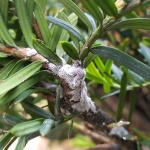 Taxus Mealybug: Dysmicoccus wistariae will produce honeydew and lead to sooty mold growth, yellowing of needles, and sparsely foliated plants. Eventual dieback may be possible. This species is commonly associated with taxus in New England, but can be occasionally found on dogwood, rhododendron, Prunus spp., maple, andromeda, and crabapple. These mealybugs are found on stems and branches and particularly like to congregate at branch crotches. Taxus mealybug feeds in the inner bark tissue of the trunk and branches. Adult females are present from June to August and give birth to living young in the summer. Immatures overwinter. A single generation may occur per year in New England, but areas to the south can have multiple generations of this insect. Management may be targeted between 246-618 GDD’s, base 50°F. Horticultural oil and neem oil may be used.
Taxus Mealybug: Dysmicoccus wistariae will produce honeydew and lead to sooty mold growth, yellowing of needles, and sparsely foliated plants. Eventual dieback may be possible. This species is commonly associated with taxus in New England, but can be occasionally found on dogwood, rhododendron, Prunus spp., maple, andromeda, and crabapple. These mealybugs are found on stems and branches and particularly like to congregate at branch crotches. Taxus mealybug feeds in the inner bark tissue of the trunk and branches. Adult females are present from June to August and give birth to living young in the summer. Immatures overwinter. A single generation may occur per year in New England, but areas to the south can have multiple generations of this insect. Management may be targeted between 246-618 GDD’s, base 50°F. Horticultural oil and neem oil may be used.- Twolined Chestnut Borer: Agrilus bilineatus is a native jewel beetle (also known as a flatheaded borer) in the Family Buprestidae. This insect is also in the same genus as the invasive emerald ash borer. The twolined chestnut borer is native to Massachusetts, much of New England, and the eastern United States. This species has one generation per year and adults are typically active from April – August, depending upon location and temperature. Adults will conduct some maturation feeding on oak prior to mating. Females will lay clusters of tiny eggs in the cracks and crevices of bark. Larvae hatch from the eggs in 1-2 weeks and burrow through the bark into the cambium, where they feed in a similar manner to the emerald ash borer, creating meandering galleries as they feed. (The galleries of the twolined chestnut borer can be straight in very stressed trees.) Larvae typically mature by August – October and burrow to the outer bark where they create a chamber in which they overwinter. Pupation occurs the following spring and adults emerge through D-shaped exit holes that are approximately 1/5 inch wide. In the northern extent of this insect’s range, they can take 2 years to complete their life cycle. Larvae of this insect have been recorded from eastern white oak, common post oak, burr oak, scarlet oak, northern red oak, and eastern black oak. Adults have been recorded on fir and pin oak. These insects are attracted to stressed host plants and typically become a secondary factor in the decline of the tree.
- Viburnum Leaf Beetle: Pyrrhalta viburni is a beetle in the family Chrysomelidae that is native to Europe, but was found in Massachusetts in 2004. Viburnum leaf beetle overwinters as eggs laid in capped pits on the newest growth of susceptible viburnum branches. Scout for overwintered eggs and prune out and destroy before they hatch. Egg hatch occurs in late-April to early-May as temperatures warm and foliage becomes available. Monitor for larvae in mid-May (80-120 GDD’s). This beetle feeds exclusively on many different species of viburnum, which includes, but is not limited to, susceptible plants such as V. dentatum, V. nudum, V. opulus, V. propinquum, and V. rafinesquianum. Some viburnum have been observed to have varying levels of resistance to this insect, including but not limited to V. bodnantense, V. carlesii, V. davidii, V. plicatum, V. rhytidophyllum, V. setigerum, and V. sieboldii. More information about viburnum leaf beetle may be found at http://www.hort.cornell.edu/vlb/ .
- Woolly Elm Aphid: Eriosoma americanum females lay a single egg in the cracks and crevices of elm bark, where the egg overwinters. Eggs hatch on elm in the spring as leaves are unfolding. Aphids may be active from 121-246 GDD’s, base 50°F on elm. A young, wingless female hatched from the egg feeds on the underside of leaf tissue. This female aphid matures and gives birth to 200 young, all females, without mating. These aphids feed, and the elm leaf curls around them and protects them. By the end of June, winged migrants mature and find serviceberry hosts. Another set of females is produced. These new females crawl to and begin feeding on the roots of serviceberry. Multiple generations occur on the roots of serviceberry through the summer.
Concerned that you may have found an invasive insect or suspicious damage caused by one? Need to report a pest sighting? If so, please visit the Massachusetts Introduced Pests Outreach Project: http://massnrc.org/pests/pestreports.htm .
Reported by Tawny Simisky, Extension Entomologist, UMass Extension Landscape, Nursery, & Urban Forestry Program
Weeds
Landscape mulch should be the first defense against weeds in landscape beds. Mulching can be done now at the beginning of the season before summer annual weeds germinate. Small winter annual weeds can be smothered with mulch. Freshly mulched landscape beds will not immediately require a preemergence herbicide application because the fresh mulch should supply adequate summer annual weed control in the short term. Preemergence herbicide application should be considered on mulched areas that have not been freshly mulched or can be applied later in the season in those areas that were freshly mulched this spring. Preemergence herbicides should be applied on top of landscape mulches, not underneath them. Compost is not recommended as a mulching material.
Inspect areas of the landscape where new trees or shrubs, especially those that were field grown, have been planted in the last year. Look for perennial weeds that may be growing from the root ball. Canada thistle, mugwort, quackgrass, bindweed and horsenettle are some of the possible culprits. Perennial weeds can be spot treated with glyphosate products.
Do not attempt to control Japanese knotweed (Polygonum cuspidatum) currently as herbicide applications are not effective. In preparation for a late season herbicide application, cut or mow stands of knotweed to the ground in late May and early June. This practice is done to facilitate herbicide application by removing the dried stems from the previous year’s growth and will control plant height so knotweed will be shorter at time of treatment in late summer. There is also some indication that the plant’s carbohydrate reserves may be reduced with this early season mowing.
Many landscape trees commonly produce vegetative suckers at their trunk base. Suckers are commonly seen on crabapple, flowering cherry, flowering pear, plum, linden, maple and sometimes oak. Honeylocust commonly produces vegetative sprouts along the entire length of their trunks. If these suckers or sprouts are not controlled, the landscape will be a contender for the “Shabby Landscape Award”. Pruning is effective but very time consuming. Another option would be to use the product Scythe that contains pelargonic acid to remove these vegetative suckers and sprouts when they are very small. Very small means less than one inch in length. Pelargonic acid is a contact herbicide. If Scythe is applied to small suckers and sprouts the product will desiccate them and physical removal will not be required. Larger growth will first need to be physically removed and then Scythe can be used as a maintenance program. Products that contain glyphosate should not be used as glyphosate is a translocated/systemic herbicide and injury to the whole plant is possible.
Report by Randy Prostak, Weed Specialist, UMass Extension Landscape, Nursery and Urban Forestry Program
Landscape Practices
Mulch 101
The Benefits of Mulching
Mulching is a common landscape practice for a reason; it can benefit plant and soil health along with providing aesthetic appeal. It is important to apply mulch appropriately, applying mulch no more than a 1-3” thick layer. Mulch over the root ball of plants should be minimal, only 1-2”, and mulch should not be touching stems or trunks.
Benefits of applying wood-product mulches:
· Reduces evaporation from the soil surface (increasing soil moisture)
· Increases soil organic matter as decomposition occurs thus improving soil structure and drainage as well as encouraging mycorrhizal activity
· Encourages beneficial soil organisms
· Suppresses weed growth (although weed seeds can blow in and germinate on the mulch surface)
· Reduces erosion
· Acts as an insulator, helping to moderate soil temperature, protecting plant roots
· Helps prevent mechanical damage from mowers and string trimmers that can occur when grass grows next to plants
It is generally best practice to avoid inorganic mulches. Stone and gravel can absorb or reflect heat which can damage plants and do not provide benefits to the soil like bark mulches. They can also make amending the soil difficult and can eventually sink down into the soil. Plastic mulches also don’t provide any benefits to the soil.
Avoiding Mulch Volcanoes
When it comes to mulch there is such a thing as too much of a good thing. Too frequently mulch is applied in excessive amounts, either directly around the base of plants or around landscape beds in general. “Mulch volcanoes”, which is mulch mounded around the base of plants, can have many negative impacts on plant health. When mounded around the base of plants, mulch can result in excessive moisture leading to decay along with predisposition to insect and disease problems. Secondary root formation can also occur, which is the formation of roots above the trunk flare in the mulch areas. These roots often circle the trunk, gradually girdling the tree if not carefully removed. When mulch is applied too thickly throughout the landscape bed it can have contrasting negative impacts on water movement through the mulch and to the soil. In some cases, the thick mulch absorbs and holds the water, preventing it from infiltrating to the soil and leaving it unavailable for plant uptake. Other times, the water does infiltrate to the soil but the thick mulch layer prevents evaporation from occurring, leading to the soil staying too wet leading to rot problems and reduced oxygen in the soil.
Potential Problems
Sour mulch and fungi can be unpleasant problems resulting from wood-product mulch applications. Sour mulch is a problem that occurs during production and is the result of mulch being piled too high. In very large piles compaction and heating can occur at the base of the pile, resulting in anaerobic conditions and the buildup of organic acids which can lower the pH of the mulch. When sour mulch is applied in the landscape it can lead to the rapid decline of plant material and a foul smell. If sour mulch is unknowingly applied to the landscape, spreading the mulch thin and watering heavily can leach the toxins. Sour mulch should also be moved away from plants to avoid damage. It is important when developing mulch or wood chip piles to make sure they are not piled higher than 10’.
Fungi such as slime molds, bird’s nest fungi, artillery fungus, stinkhorns, and mushrooms are often found in mulches. These fungi are associated with mulches because of the decomposition of the mulch. In general, these fungi are not harmful to plants, and are not associated with health hazards unless consumed. Most of these fungi are just visual nuisances. Artillery fungus however can be a problem as expelled spore masses can stick to homes and vehicles, and are difficult to remove. When removed they can leave a stain. These fungi are most prevalent with moist rotting mulch especially in cool northern facing locations. Disturbing the mulch in areas that are conducive to artillery fungus can help dry out the area and make it less ideal for the fungus. Replacing mulch and freshening mulch can also help.
Sources:
Kujawski, R. and D. Swanson. 2011. Sour Mulch. UMass Extension.
Pettinelli, D. Mulch Basics. University of Connecticut.
Smith, T. 2011. Fungi in Mulches and Composts. UMass Extension.
The Morton Arboretum. Mulching trees and shrubs.
Report by Mandy Bayer, Extension Assistant Professor of Sustainable Landscape Horticulture, UMass Stockbridge School of Agriculture
Additional Resources
Pesticide License Exams - The MA Dept. of Agricultural Resources (MDAR) is now holding exams online. For more information and how to register, go to: https://www.mass.gov/pesticide-examination-and-licensing.
To receive immediate notification when the next Landscape Message update is posted, join our e-mail list or follow us on Facebook.
For a complete listing of upcoming events, see our upcoming educational events https://ag.umass.edu/landscape/upcoming-events
For commercial growers of greenhouse crops and flowers - Check out UMass Extension's Greenhouse Update website
For professional turf managers - Check out Turf Management Updates
For home gardeners and garden retailers - Check out our home lawn and garden resources.
Diagnostic Services
UMass Laboratory Diagnoses Landscape and Turf Problems - The UMass Extension Plant Diagnostic Lab is available to serve commercial landscape contractors, turf managers, arborists, nurseries and other green industry professionals. It provides woody plant and turf disease analysis, woody plant and turf insect identification, turfgrass identification, weed identification, and offers a report of pest management strategies that are research based, economically sound and environmentally appropriate for the situation. Accurate diagnosis for a turf or landscape problem can often eliminate or reduce the need for pesticide use. For sampling procedures, detailed submission instructions and a list of fees, see Plant Diagnostic Laboratory
Soil and Plant Nutrient Testing - The University of Massachusetts Soil and Plant Nutrient Testing Laboratory is located on the campus of The University of Massachusetts at Amherst. Testing services are available to all. The lab provides test results and recommendations that lead to the wise and economical use of soils and soil amendments. For more information, visit the UMass Soil and Plant Nutrient Testing Laboratory web site. Routine soil analysis and particle size analysis ONLY (no other types of soil analyses available at this time). Turnaround time: Please plan for the fact that date of receipt in the lab is affected by weekends, holidays, shipping time, and time for UMass Campus Mail to deliver samples to the lab. Campus Mail delivery only takes place on Monday, Wednesday, and Friday due to pandemic restrictions.
Tick Testing - The UMass Center for Agriculture, Food, and the Environment provides a list of potential tick identification and testing options at: https://ag.umass.edu/resources/tick-testing-resources.
